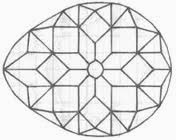Legendary 400-year-old Beau Sancy diamond expected to fetch up to 4 million at auction
- The unique 35-carat flawless gem has 110 perfectly symmetrical facets - the first of its type to be cut more than four centuries ago

The diamond is of Indian origin, as the initial printed record of its life is in the late 16th century, when the diamond came into the control of Nicholas Harlay de Sancy, representative and financier directly connected with the royal family of France.
India was the only known basis of diamonds in this period. The first name used for the pear-shaped, 34-carat, pale diamond prior to it belonging to Sancy's hands is not identified.
But, it is thought that the stone was part of the jewels that belonged to Charles the Bold, the Duke of Burgundy, who also owned the other Sancy diamond, the Great Sancy, which he used to carry into battle in the belief that it brought good luck.
Charles the Bold was the last of the big dukes of Burgundy, who ruled among 1467 and 1477. Charles the Bold, according to history, presented three diamonds in 1475 to the well-known diamond cutter Louis de Berquem of Bruges- the inventor of the recent art of diamond faceting-for cutting and cleaning.
One of these diamonds, later named the "Beau Sancy", was among them and the first diamond ever cut in a pear shape, thus increasing its value significantly. The second diamond was offered to Pope Sixtus IV and the third diamond to King Louis XI of France. Following Charles the Bold's death in 1477, no one knows what happened to it until it resurfaced in Constantinope over a hundred years later.
Nicholas Harlay de Sancy was a man of great wealth as well as a member of the economic council of both Henry III and Henry IV. He was also a collector and authority of diamonds. Most believe he purchased the Sancy and the Beau Sancy when he was serving as a ambassador in Constantinople, Turkey in the 1570s. It is from him that the diamonds got their names.
 Nicholas Harlay de Sancy was an enthusiastic monarchist and in 1589 he is supposed to have sold some of his diamonds to assist Henry III to help pay for a mercenary army, in the French civil war between the Protestants (Huguenots) and the Catholics.
Falling on hard times,In 1604 he put up for sale the Great Sancy diamond to King James I, the heir to the childless Queen Elizabeth I and the first Stuart King of England.
The smaller diamond,the Beau Sancy, was put up for sale in the same year, 1604, to Marie de Medicis, the Queen of King Henry IV of France. Marie de Medicis had the Beau Sancy diamond placed in the crown which she wore for her coronation in 1610.
But, unfortunately her husband King Henry IV was killed in the same year, and was succeeded by her son King Louis XIII, who was just nine years old.
Marie de Medicis acted as regent awaiting Louis XIII coming of age, and dedicated herself to the dealings of the state. In 1617 when he was 16, Louis XIII, offended at being barred from power, got his mother deported to Blois with the help of his contiguous counselor Charles d'Albert, who soon turned into the main figure in the government.
She returned to Paris with the aid of a man named Richelieu. However,he fell out with Marie de Medicis over his strategy of refusing the Franco-Spanish alliance, as an alternative behind the Protestant powers. In February 1631, Marie de Medicis was banished for the second time to Compiegne, from where she escaped to Brussels in the Spanish Netherlands (presently Belgium), never to return to France. She died in 1642.
While in Brussels she was in terrible financial straits and sold the majority of her belongings. She also sold the Beau Sancy diamond to Prince Frederick Henry, the Prince of Orange of the Netherlands, for 80,000 florins.
In 1677 William III of the Netherlands married his cousin Mary, daughter of James, the duke of York, who then became King James II of England.Â
After his father-in Law, King James II a Roman Catholic, had provoked his subjects by his autocratic and romanizing policies, William of Orange, the Stadholder of Netherlands, attacked England on 15th November 1688. James II was forced to flee to France and King William III and Queen Mary II were crowned as combined rulers of Great Britain.
William III claimed the Beau Sancy and offered it to his spouse Queen Mary II, as a wedding gift. The couple were childless and the diamond came into the control of a new grandson of Prince Frederick Henry, Frederick III, Prince of Brandenburg, who in 1701, became the King of Prussia. TheModern History
Beau Sancy became the most significant stone in the crown jewels of Prussia and was placed in the royal crown. In an accounting of the crown jewels in 1913, the Beau Sancy was featured as the pendant to a necklace finished of 22 diamonds.
Currently, The Beau Sancy is in the control of the head of thehouse of Hohenzollern, Prince Louis-Ferdinand of Prussia, grandson of Kaiser William II, the last emperor of Germany and ruler of Prussia..



